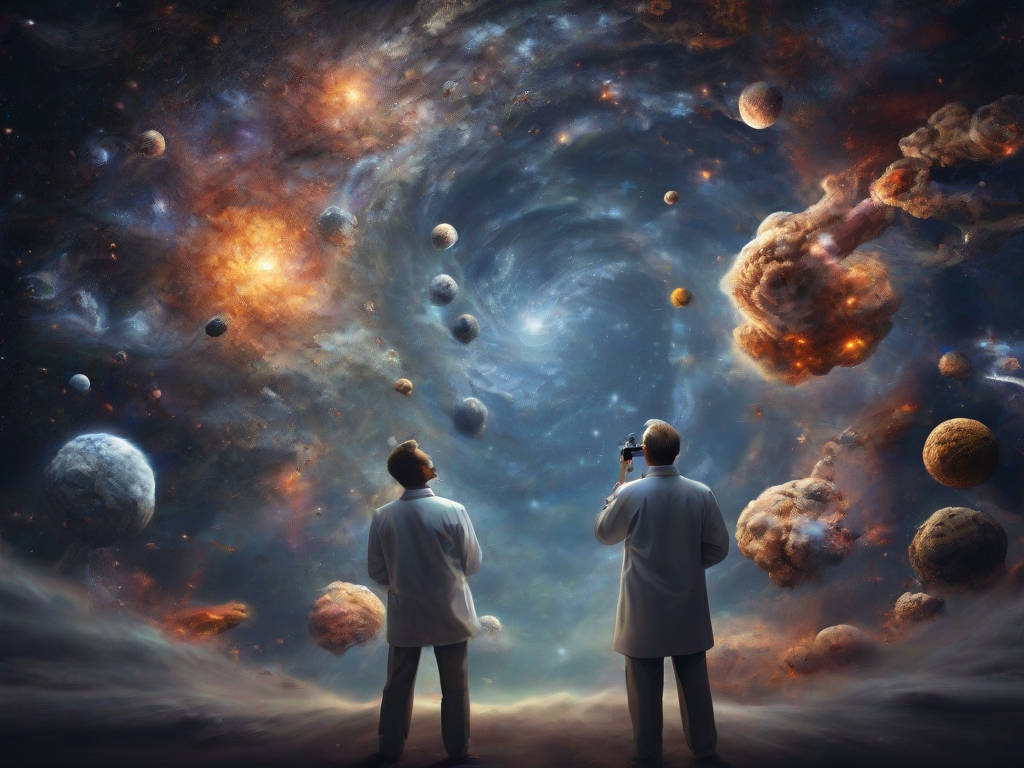Universe
IV. UNIVERSE¶

(Image credit: Leonardo AI)
This is the fourth Volume of the series MODERN PHYSICS BY EXPLORING NOBEL PRIZES. It refers to understanding some aspects of the universe. According to Carl Sagan: “the universe is all that existed, exists and will exist”. Understanding requires asking questions and proposing answers that foster the improvement of knowledge. It means to bite the unknown.
The study of the universe is like archaeology in the sense that it concerns the reconstruction of what is past and like history because it consists in the interpretation of what has been registered. The traces of the past serve to interpret the present and propose radiographies of possible futures.
Physics, as a natural science, deals with objects and forces acting in regions that existed since the beginning of time, as well as in regions observed nowadays in modern accelerators of particles. The ways of building and applying concepts, models and research methodologies have evolved in universes integrated by particles, waves, matter and energy. To study those universes mathematics serves as bridges for solving problems and ladders for attaining better and better explanations.
In this Volume IV we review and comment the essential nodes of a cognitive network of explanations, discoveries, and inventions that have been recognized with Nobel Prizes, mostly in Physics and few in Chemistry. Chapters 16 (Development of knowledge in high energy physics) and 17 (Evolution of cosmology) deal with high energy physics which comprehends nuclear physics, particle physics and cosmology. These regions of the universe differ in the size of its components and the intensity of the energies involved. The Chapters of this fourth Volume are the following:
Since the atoms were not considered as indivisible, the study of its nuclei became interesting and possible due to more advanced theoretical interpretations of matter and energy, as well as to the fact that the realization of experiments had the support of complex technological infrastructures and extensive systems of collaboration. First, physicists and chemists studied radioactivity and discovered that atoms contained protons, neutrons and electrons. Then they start understanding and even provoking nuclear reactions resulting in new elements, isotopes, particles, strange entities called quarks, and great amounts of energy.
The existence of four types of forces was revealed: the gravitational force and the electromagnetic force already studied in classic physics, the weak force (responsible for the radioactive decay of atoms) and the strong force (responsible for the creation of atomic nuclei). The Standard Model of Particle Physics provided a uniform framework for understanding electromagnetic, weak, and strong forces. Nevertheless, theoretical schemes of classification of particles have not been successful to include in satisfactory ways the gravitational force.
Three levels of operation of the mechanisms of knowing are associated with contributions made by Nobel laureates: the laboratory instruments relates to the level intra for the description of objects, the experimental results relate to the level inter for the transformation of concepts, and the theoretical approaches relate to the level trans for the construction of structures.
Aside from the human eyes, the first devices for observing bodies outside Earth were optic telescopes. Afterwards, different technologies changed the wavelength of the electromagnetic radiation used to detect the positions and structure of planets, stars, moons, comets, galaxies, pulsars, and even black holes. As data obtained from farthest events correspond to the oldest ones to be registered, modern astronomical observatories are telling us what happened in the first moments of the universe.
Complicated and longtime astronomical observations and measurements lead to the detection and explanations of new phenomena such as the following: the neutrino oscillations (when and how they were produced and detected, the existence of three types of them and the possibilities that they have mass), the cosmic microwave background radiation (a remnant of the Big Bang when the universe was created producing a spectrum corresponding to black-body radiation), the accelerating expansion of the universe (discovered through observations that some galaxies were rushing away from us and each other, and the farther away they were, the faster they moved), and the existence of an exoplanet orbiting a solar-type star (the star moved affected by the gravity of its planet).
The elements characterizing contextualization of learning (the proposition of a problematic situation, the elaboration of generating questions and the description of learning and evaluation activities) are applied to analyze the content of Peebles´ Nobel Lecture How Physical Cosmology Grew.
16. Development of knowledge in high energy physics¶
16.1. Descriptions of laboratory instruments¶
16.2. Accounts of experimental results¶
16.3. Contributions made by theoretical approaches¶
17. Evolution of cosmology.¶
17.1. Stars, pulsars, and black holes¶
17.2. Neutrino oscillations, background radiation, accelerating expansion, and exoplanets¶
17.3. Contextualization of learning about the universe¶
18. Understanding of complex physical systems (2021 Physics Nobel Prize). - TBD¶
19. Machine learning with artificial neural networks (2024 Physics Nobel Prize) - TBD¶
20. Universes composed by humans and societies¶
20.1. Selection of Prizes in Economic Sciences in Memory of Alfred Nobel¶
20.2. Role of statistical analysis in the formulation of models (1969 Economics Nobel Prize)¶
20.3. Interpretation of natural experiments in Economic sciences (2021 Economics Nobel Prize)¶
Created: 2023-03-12; Updated: 2025-12-10
Barojas-Weber, J.R., & Lizárraga-Celaya, C. (2023). Modern Physics through Nobel Prizes.
Creative Commons: Attribution-NonCommercial-ShareAlike 4.0 International
![]()